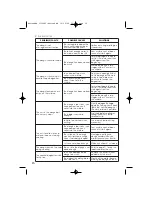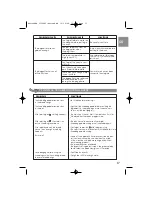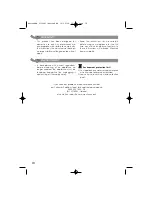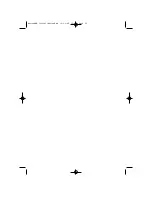
10
In the event you use a mix of different types of
flour for bread or brioche or milk bread, do not
exceed 1000 g of dough in total for the bread
pan and 450 g of dough in total for baguettes.
The more the flour is whole (i.e. the more of
the outer envelope of the wheat it
contains), the less the dough will rise and
the denser the bread. You can also find
ready-to-use bread mixes on the market.
Follow the manufacturer’s instructions
when using these preparations. Usually, the
choice of the programme will depend on
the preparation used. For example:
Wholemeal bread - Programme 3.
• Sugar:
use white sugar, brown sugar or
honey. Do not use unrefined sugar or
lumps. Sugar acts as food for the yeast,
gives the bread its good taste and
improves browning of the crust. Artificial
sweeteners cannot be substituted for
sugar as the yeast will not react with them.
• Salt:
salt gives taste to food and regulates
the yeast’s activity. It should not come into
contact with the yeast. Thanks to salt, the
dough is firm, compact and does not rise
too quickly. It also improves the structure of
the dough. Use ordinary table salt. Do not
use coarse salt or salt substitutes.
• Yeast:
yeast is what makes the dough rise.
Dried yeast exists in several forms: fresh; dried
granules (which need to be rehydrated with
water first), and instant dried yeast called
'Fast Action', 'Easy Bake' or 'Easy Blend'. Fresh
yeast is sold in supermarkets which have an
in-store bakery, but you can sometimes buy it
from your local baker’s.
In its fresh or instant ‘Fast Action’ form, yeast
should be added directly to the baking pan of
your bread maker with the other ingredients.
Remember to crumble the fresh yeast with
your fingers to make it dissolve more easily.
Only active dried yeast (in small granules),
usually sold in small tins, must be mixed
with a little tepid water before use. Choose
a temperature close to 37°C, or slightly less
otherwise it will not rise as well. Too hot a
temperature may make it lose its rising
power. We do not recommend using this
type of yeast in the Moulinex Home Bread
Baguette Bread Maker.
When using yeast keep to the stated
amounts in the recipe. If adapting recipes
to use fresh yeast, remember to adapt the
quantities (see equivalents chart below).
Equivalents in quantity/weight between
dried yeast and fresh yeast:
• Additives
(olives, bacon pieces, etc.): you can
add a personal touch to your recipes by adding
whatever ingredients you want, taking care:
> to add additional ingredients following
the beep, especially those that are
fragile, such as dried fruit,
> to add solid grains and seeds (such as
linseed or sesame) at the start together
with the flour so that they are evenly
dispersed through the dough,
> to thoroughly drain moist ingredients (olives),
> to lightly flour fatty ingredients for better
blending,
>
not to add too large a quantity of
additional ingredients, especially cheese,
fresh fruit and fresh vegetables, as they can
affect the development of the dough,
> to finely chop nuts as they can cut
through the loaf structure and reduce
the cooked height.
> For dried spices and herbs only use a
small amount, about 1-21/2 teaspoons.
BAGUETTE RECIPE
Dried yeast
(in tsp.)
1 11/2 2 21/2 3 31/2 4 41/2 5
Fresh yeast
(in g)
9
13
18
22
25
31
36
40
45
For this recipe, you will need all the baguette
accessories supplied: 1 baguette baking
rack (5), 2 non-stick baking trays (6), 1 razor
cutter (11) and 1 brush (10).
RECIPE TO MAKE 4 X 100 G BAGUETTES
(programme )
Crust colour
> Medium
Ingredients:
Water
> 160 ml
Salt
> 3/4 teaspoon
Sunflower oil
> 1 tablespoon
Strong white bread flour > 280 g
Fast action or easy
blend dried yeast
> 1 teaspoon
TIP
For a crustier baguette, with a harder crust,
omit the 1 tablespoon of sunflower oil.
NoticeHBB_3316683:NoticeHBB 19/12/08 12:05 Page 10






































